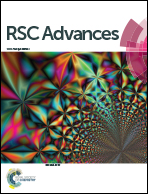Synthesis and in vitro phantom NMR and MRI studies of fully organic free radicals, TEEPO-glucose and TEMPO-glucose, potential contrast agents for MRI†
Abstract
Two organic radical contrast agents, TEMPO-Glc and TEEPO-Glc, were synthesized and their stabilities and contrast enhancing properties were tested with in vitro NMR and MRI experiments. Owing to the glucose moieties in the prepared compounds, this study presents potential candidates for a tumor targeting fully organic contrast agents for MRI.


 Please wait while we load your content...
Please wait while we load your content...